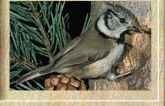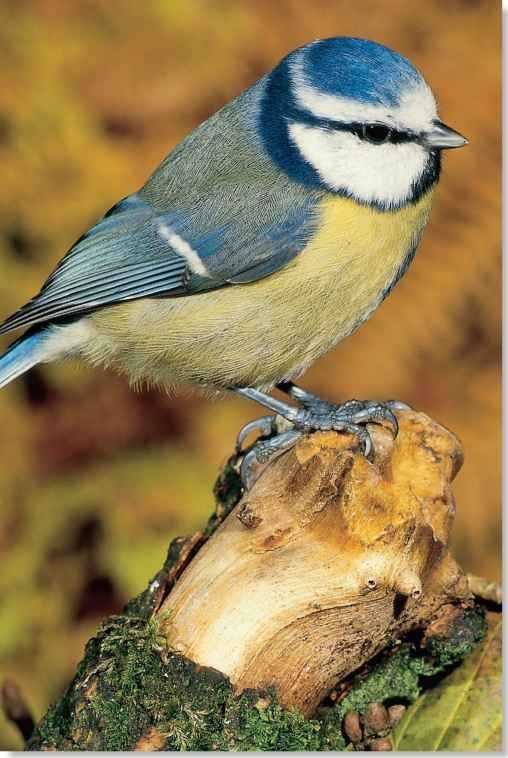ORDER
Passeriform.es
FAMILY
Paridae
GENUS & SPECIES
KEY FEATURES
• A small, common bird with striking blue and yellow plumage
• Forages in woodlands and hedges for small invertebrates
• A visitor to garden bird feeders, where it shows acrobatic skill and a flair for obtaining food from awkward places
• Forms flocks in winter, mixing with other species to find scarce food
WHERE IN THE WORLD?
Breeds throughout most of Europe as far east as Russia and Ukraine; also common in northwestern Africa; occurs in Middle East ‘ from Turkey and Syria to Iraq

Lifecycle
With unflagging energy, the blue tit explores its surroundings, searching crevices for tasty morsels and holes for potential nesting sites.
HABITAT
The blue tit thrives in wooded habitats, including palm-fringed Saharan oases and Mediterranean olive groves, avoids conifer plantations, preferring deciduous trees.
On agricultural land, the blue tit inhabits orchards, thickets and hedgerows, and is often found around farmyards in winter; when the weather turns cold, it forages on open fields and among reedbeds.
The blue tit’s familiarity as a garden bird has grown with the increase in nestboxes and bird feeders. Parks and tree-lined avenues also provide suitable breeding territories.
Tiny but tough The blue tit is a hardy bird and can survive the coldest winters.
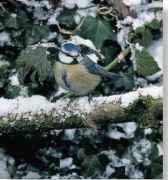
CONSERVATION
The blue tit suffers from predation and periodic failures of natural food, particularly caterpillars lost to wet summers. However, its large broods and regular use of bird feeders ensure that it remains abundant. It is common in the British Isles, where an estimated population of over 4 million pairs is double that of the great tit.
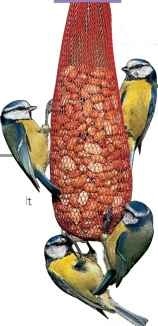
FOOD & FEEDING
The blue tit’s agility and curiosity make it an innovative foraging bird. By prodding at any object, it discovers new food sources, such as the cream at the top of a bottle of milk — a habit that began in the 1920s. The blue tit finds most of its prey among foliage, often hanging by one leg in order to inspect twigs, leaves and buds for insects. It uses similar acrobatics when sipping nectar from flowers. The bird holds nuts against a perch before cracking them open.
Experiments at bird feeders have shown the blue tit to be a good puzzle solverThis clever bird is able to do simple tasks in sequence to obtain a reward of food.
PRY AND PECK
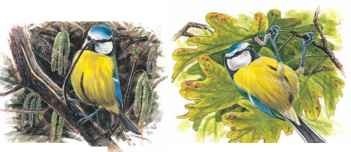
1 Strip search…
A blue tit alights on a branch and rips away scraps of loose bark, looking for hidden insects.
2 Caterpillar catering…
The tit flits over to a larva beneath a leaf. Perching acrobatically, the bird snaps up its prey.
BEHAVIOR

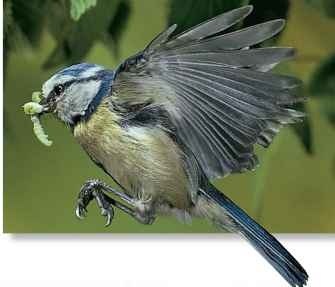
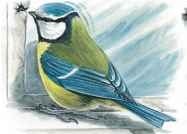
3 Lair of the spider…
In gardens, the blue tit examines crevices, including the old, cracked putty around a window frame.
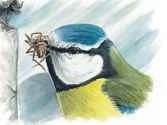
4 A juicy tidbit
The tit disturbs a spider lurking under the damaged putty and quickly snaps it up.
Pugnacious by nature, the blue tit regularly fights other small birds for food and territory in spring and summer In winter; however; it forages in mixed flocks of small birds, including goldcrests, warblers and treecreepers.The blue tit usually dominates other species in such groups, except when the more powerful great tit is present.
In winter the blue tit may move from exposed upland areas into sheltered valleys, but it rarely travels more than 6 miles from where it hatched. In Britain, the bird is sometimes joined by its more brightly colored subspecies, which make sporadic migrations when food shortages coincide with high populations.
In summer, the blue tit roosts in trees and bushes but, uses sheltered holes in winter Natural sites include hollows in trees, but nestboxes left in position after
Splash of color the breeding season also
The blue tit regularly uses provide the bird with vital garden birdbaths. nighttime accommodations.
BREEDING
In spring, the male blue tit performs displays to attract a mate, ncluding slow, gliding flights and vigorous prancing with his crest erected. The female frequently begs food from her mate, who responds by bringing her insects. This activity reinforces the pairbond and gives the female the extra nutrition she needs to produce a clutch of eggs.
The female builds a nest in a tree hole, wall crevice or nestbox from moss and grass, and lines it with feathers. She incubates the eggs alone, but both parents
feed the chicks freshly hatched ▼ Leaving the nest caterpillars, which are abundant Young blue tits fledge at at this time. about 3 weeks of age.
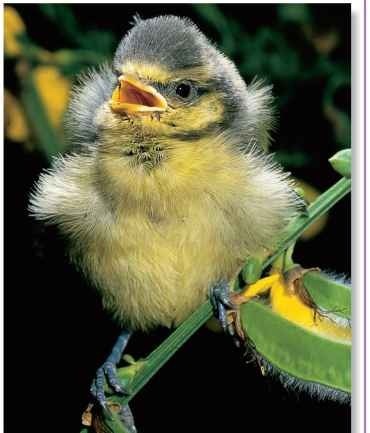
A bird feeder may be visited by over 1,000 blue tits in a single year.
A blue tit with young spends up to 17 hours a day gathering food.
Profile
Blue Tit
A tiny ball of energy, the blue tit forages restlessly for insects and nuts. Its size enables it to exploit food sources hidden from larger species.
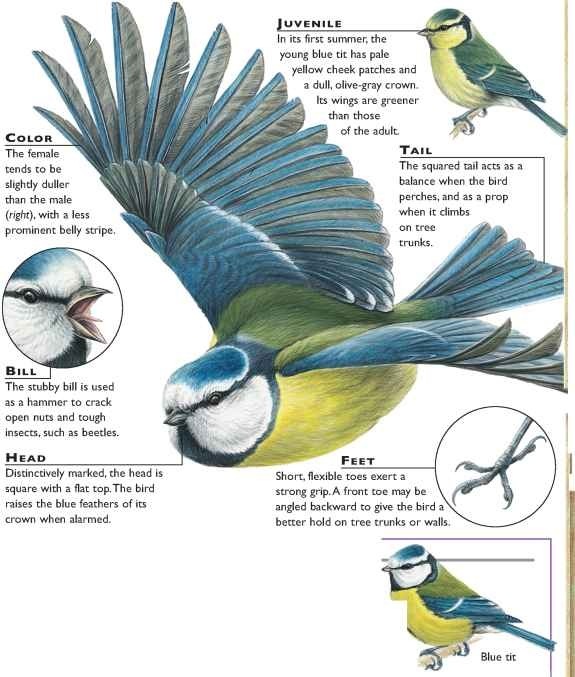
CREATURE COMPARISONS
The great tit (Parus major) ranks second to the blue tit as the most numerous member of the tit family in Europe. It is found in most of temperate and tropical Asia, as far east as Japan and Indonesia. An aggressive bird, it usually drives the much smaller blue tit from bird feeders. It has a loud voice and a varied repertoire, including a familiar and repetitive teacher-teacher song.The blue tit, by contrast, has a clearer, ringing call.The great tit eats a greater proportion of seeds and fruits than does its cousin, which feeds more commonly on insects and their larvae.

| VITAL STATISTICS | |
| Weight | 0.35-0.45 oz. |
| Length | 4.5″ |
| Wingspan | 7-8″ |
| Sexual Maturity | 1 year |
| Breeding Season | April-June |
| Number of Eggs | 6-16 |
| Incubation Period | 12-16 days |
| Fledging Period | 16-22 days |
| Breeding Interval | 1 or 2 broods a year |
| Typical Diet | Insects, spiders, seeds, nuts and fruit |
| Lifespan | Up to 12 years; usually 4-6 |
RELATED SPECIES
• The blue tit and the azure tit, Parus cyanus, are so closely related that they can interbreed. The genus Parus,to which both species belong, contains 40 species, 6 of which occur in Britain including the crested tit, P. cristatus (below).
